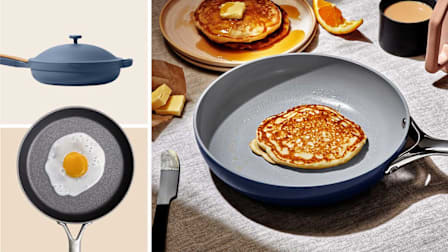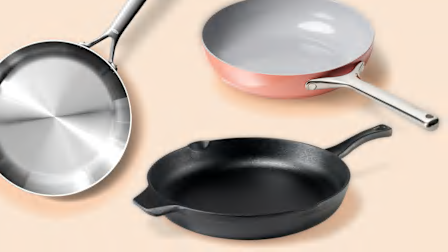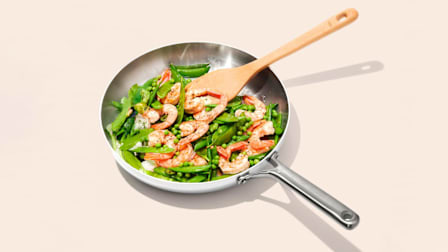Does the Always Pan Cook as Good as It Looks?
CR tested the heavily hyped skillet in our cookware lab and a dedicated home cook tried it out in her kitchen for a month
When you shop through retailer links on our site, we may earn affiliate commissions. 100% of the fees we collect are used to support our nonprofit mission. Learn more.
Update, August 4, 2023: We tested the original Always Pan in early 2022, evaluating it in our labs and at home as described below. Since then the manufacturer, Our Place, tweaked the design to address consumer complaints about the durability of the nonstick coating and the fact that the pan wasn’t ovenproof. Recently, we tested the Always Pan 2.0 in our cookware lab (members can see the full results below). We didn’t put the Always Pan 2.0 through a home evaluation.
As a journalist, I was taught to never say “never” and to always avoid “always.” Things rarely—or almost never—fit those extreme descriptions.
So I was dubious when I heard about the Always Pan, which was introduced in 2019 and has been popping up all over social media ever since. “Always what?” I wondered.
When Consumer Reports decided to test the Always Pan, I ordered one of the $145 nonstick skillets directly from Our Place. Our test engineers put the insta-famous pan through its paces in our cookware lab, gauging cooking evenness and non-stickability by making pancakes and fried eggs, assessing handle temperature and sturdiness, and then abrading the surface with 2,000 strokes of steel wool to test the durability of the nonstick coating.
Me? I cooked what I usually do at home, trying out several dishes in the Always Pan over the course of a month.
What's in the Box
The original 10-inch Always Pan is made of cast aluminum and comes in 10 colors. I ordered the Blue Salt to match my kitchen. (The 2.0 is slightly larger but just as colorful.) It’s super-slick-looking and has a gray ceramic nonstick coating.
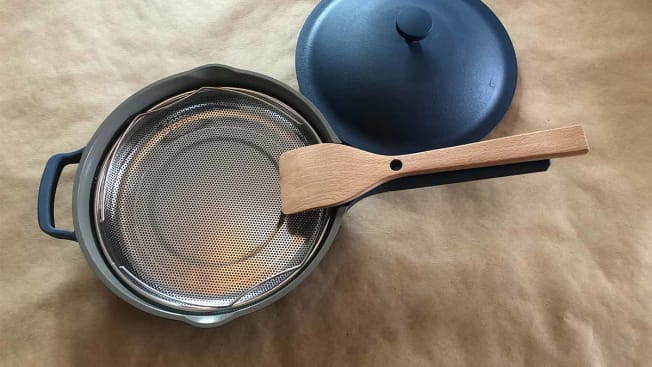
Photo: Mary Farrell/Consumer Reports Photo: Mary Farrell/Consumer Reports
The pan comes with a lid made of the same material, a wooden spatula, and a metal steamer insert (shown above). But there’s a disconnect here. The directions say not to use the pan with metal, but the steamer’s three metal legs sit right on the nonstick surface. Johanna Albertsson, an Our Place spokesperson, offered this explanation in an email: “The steamer basket’s legs are rounded, and it is designed to ‘sit still’ in the Always Pan, as opposed to scraping at the surface the way you might with a metal spatula.”
Our Place plays up that the pan and its accessories all fit together nicely, which they do, and that you can rest the spatula on the handle by matching up a circular hole in the spatula with a raised dot in the pan handle. The pan also comes with a warning that the small D-shaped lifter handle opposite the main handle gets hot—and it does.
On its site, Our Place claims that the Always Pan “replaces your fry pan, sauté pan, steamer, skillet, saucier, saucepan, nonstick pan, spatula, and spoon rest.” It also touts that with the Always Pan, “you can braise, sear, steam, strain, sauté, fry, boil, and serve.” With the new oven-safe version, you can also bake and roast.
I decided to find out.
Evaluating the Claims in the Kitchen
As an enthusiastic home cook who covers cookware for Consumer Reports, I used the Always Pan as I would any nonstick pan, cooking my usual repertory of recipes like risotto, chicken cutlets, zucchini and potato pancakes, French toast, and blueberry pancakes, to name just a few dishes.
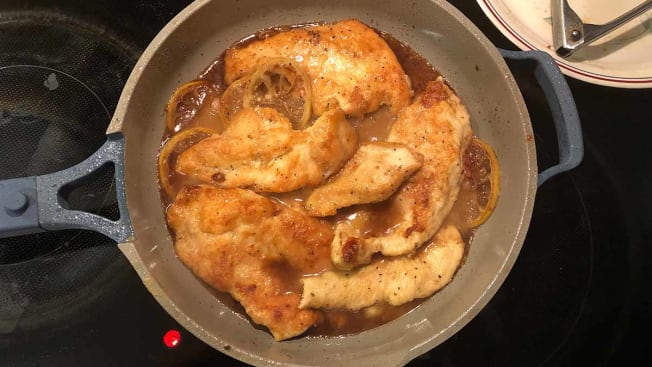
Photo: Mary Farrell/Consumer Reports Photo: Mary Farrell/Consumer Reports
That dinner was also my first (and last) foray with the steamer. Before starting on the chicken, I steamed a combo of broccoli and cauliflower, which came out fine. The Always Pan lid fits securely and prevents steam from escaping, making it an effective steamer. (But frankly, I prefer vegetables roasted, sautéed, or stir-fried.)
Sourdough bread is my go-to for French toast, and because I had some on hand, I chose that for my next trial. Usually when I brown something on medium heat, it slowly goes from undone to done, but in the Always Pan, my French toast went from undone to burnt in a very short time (at the same temperature setting I always use). So I retested the pan’s browning capability by making three types of pancakes: potato, zucchini, and blueberry. The same thing happened: burned, burned, and burned. So take care to watch and/or adjust the heat.
Another night I cooked up the filling for a calzone—hot sausage and broccoli rabe, cooked separately. The sausage browned nicely, and the broccoli rabe, sautéed with garlic and red pepper flakes, came out as tender as it does in my other pans. The calzone itself was cooked in the oven on a pizza stone, not in the pan, which couldn’t be used in the oven because the handle on the original isn’t heat-proof. That’s not an issue, however, with the Always Pan 2.0.
I didn’t sear any meat in the Always Pan because nonstick pans, by their very nature, aren’t good at searing, so why waste a good steak? Based on our test results, to get excellent searing you need a cast-iron or stainless skillet.
The Always Pan’s slick surface does have this going for it: The interior cleans like a dream, much easier than any of my other cookware. You just wipe out the inside with a paper towel. (Some nonstick pans are supposed to be dishwasher-safe, but we generally don’t recommend putting them in the dishwasher because high heat and harsh detergents can damage the coating.)
Always Pan 2.0 Lab-Test Results
At 10.5 inches in diameter, the Always Pan 2.0 is slightly larger than the original pan, which was 10 inches. And it costs $5 more ($150). Our Place claims to have improved the nonstick ceramic coating and switched the handle from aluminum to stainless steel, which makes the new version oven-safe.
So how did the Always Pan 2.0 fare in our testing? Very well. Its Overall Score rose by more than 10 points over the original, putting it solidly in the excellent range. The original pan notched a very good score. Both are among the dozens of nonstick skillets we recommend.
In our lab, the Always Pan 2.0 matched the original pan test for test, with the exception of the handle sturdiness test. The new, sturdier handle on the 2.0 performed better than the original, contributing to its higher Overall Score. The new handle also stays cool to the touch when cooking on the stovetop. Cooking evenness, based on making pancakes, was excellent, and our eggs slid out easily with just a bit of nudging in the food-release test.
The Always Pan 2.0 held up well in our nonstick durability test (in which we swipe steel wool over the surface 2,000 times). But some other pans do better. Still, the Our Place spokesperson emphasized that with a little TLC, the pans will last. “With proper usage, such as avoiding high flames, never heating an empty pan or placing it in the dishwasher, we expect our coatings to last, and we’re actively sharing these care tips with our customers,” Albertsson said.
The Bottom Line
Should you buy an Always Pan? That depends on how happy you are with the cookware you already own. If you’re just starting out, an easy-to-wash Always Pan might serve as a good choice for frying eggs, steaming, and cooking dishes that require a little more space than a standard skillet. But other pans do just as good a job for far less.
Check out our cookware ratings for lots of choices, ranging from other nonstick pans to cast iron, copper, stainless steel, and carbon steel pans. If you already have a fully stocked kitchen, you might decide there’s no room for one more pan with limited uses.
Based on my experience, and despite the robust marketing claims, I wouldn’t replace any of my current nonstick, cast-iron, or stainless steel frying pans with an Always Pan. Even though I collectively have more pans, each has individual strengths that I found lacking with the Always Pan. Maybe it just doesn’t fit my cooking style, but more likely the Always Pan’s performance reinforces the fact that no one pan can do it all. In addition, with its lid, steamer insert, and spatula, it takes up more real estate in my cabinet than a typical skillet, space I’d rather devote to another piece of cookware that does the job it was made to do with perfection.
Interested? You can buy the Always Pan from Our Place or retailers that include Nordstrom, Saks Fifth Avenue, and World Market. Not interested? There are lots of good alternatives in our nonstick frying pan ratings, including the options listed here in alphabetical order.






























